How to Start a Sugar Free Diet: Easy Tips for Beginners
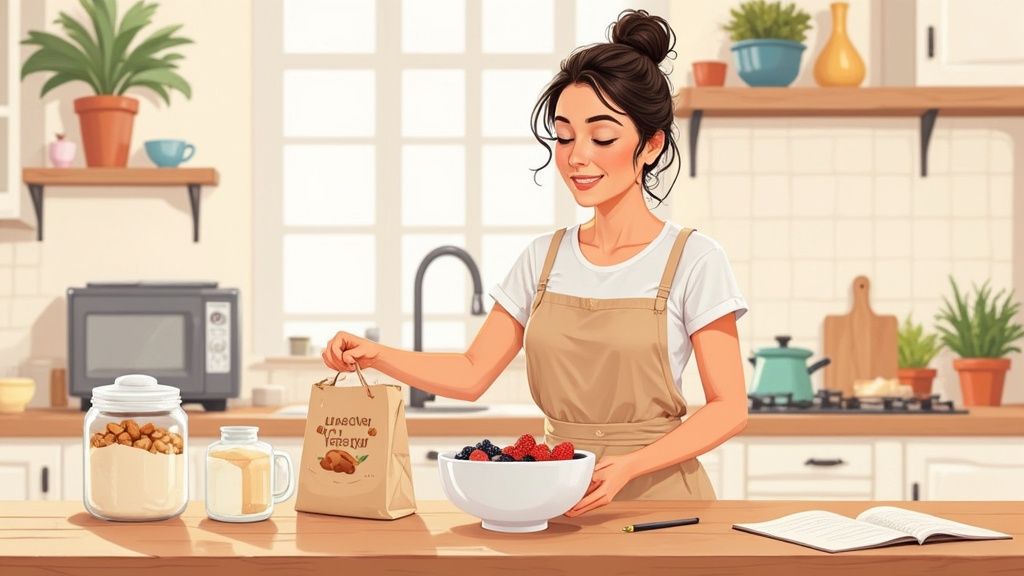
Understanding What You’re Really Up Against
Let's be honest, kicking sugar is hard. It's not just a matter of willpower. From my own journey and chatting with others, I've learned there are some sneaky things working against you, making this change tougher than it seems.
One of the first things you'll notice? Sugar is everywhere. It's not just the obvious stuff like cookies and soda. It's hiding in "healthy" granola, yogurt, even savory sauces. The food industry has made it practically impossible to avoid.
This constant bombardment trains our brains to crave sweets. Remember that happy feeling you get after a sugary treat? Your brain loves it and wants more. It's biology, not a weakness. Plus, think about how many social events revolve around sugary foods. Birthdays, holidays, office parties… it's tough to resist when everyone else is indulging.
This means going sugar-free isn't just about changing your shopping list. It's about changing your habits and your mindset.
The Science Behind the Struggle
Beyond those initial cravings, there are deeper reasons why quitting sugar is so difficult. Sugar is addictive, plain and simple. It triggers the release of dopamine, the pleasure and reward neurotransmitter. This sets up a cycle of craving, consuming, and craving again. You're on a sugar rollercoaster.
I remember my first sugar-free week vividly. The headaches, the fatigue, the intense cravings. It felt like I was fighting my own body! Knowing these withdrawal symptoms are normal and temporary is key to making it through.
And it’s not like the world is helping. Global sugar consumption is on the rise. In 2023, a whopping 200.1 million metric tons of sugar were consumed globally, up from 196.3 million metric tons in 2022. That's about 17 kilograms of sugar per person every year, with some countries hitting over 40 kilograms per person! Check out these insights on global sugar consumption. This easy access and widespread consumption make a high-sugar diet seem normal, making it even harder to break free.
Real Transformations, Real Stories
But don't lose hope. Despite these hurdles, tons of people successfully ditch sugar. And the benefits are amazing. I've heard firsthand from friends and family about increased energy, better sleep, improved focus, and even weight loss. And these aren't just stories. Research backs up the positive effects of cutting back on sugar.
One friend told me how she used to hit a wall every afternoon, needing caffeine to get through the day. After giving up sugar, her energy stabilized, and she no longer needs that afternoon coffee. Another friend mentioned how much better they sleep after ditching their nightly dessert.
These real-life wins prove you can overcome the challenges. It's about understanding the obstacles—the cravings, the omnipresent sugar, the social pressures—and finding ways to handle them. It’s about working with your body, not against it.
Setting Up Your Environment for Actual Success
Before you even think about changing what you eat, let's talk about your eating and shopping environment. This isn't about a perfectly Instagrammable pantry; it’s about creating a space that genuinely helps you achieve your sugar-free goals. When I started, simply tossing the obvious sugary snacks wasn't enough. Hidden sugars were everywhere!
So, we need a realistic kitchen makeover. This goes way beyond the candy jar and involves scrutinizing those “healthy” foods secretly packed with sugar. Think flavored yogurts, granola bars, and even some whole-wheat bread. They often contain added sugars you might not even notice.
The Kitchen Cleanse: Out With the Old, In With the New
First, pinpoint your biggest temptations. Late-night ice cream was my downfall. Once you know your weaknesses, finding alternatives is easier. I swapped ice cream for frozen berries and a bit of unsweetened dark chocolate. It satisfied my sweet cravings without the sugar crash.
Next, trade sugary staples for sugar-free versions. This absolutely doesn't mean deprivation! There are tons of tasty alternatives available these days. Take a look at this infographic; it summarizes some fantastic benefits of cutting back on added sugar:
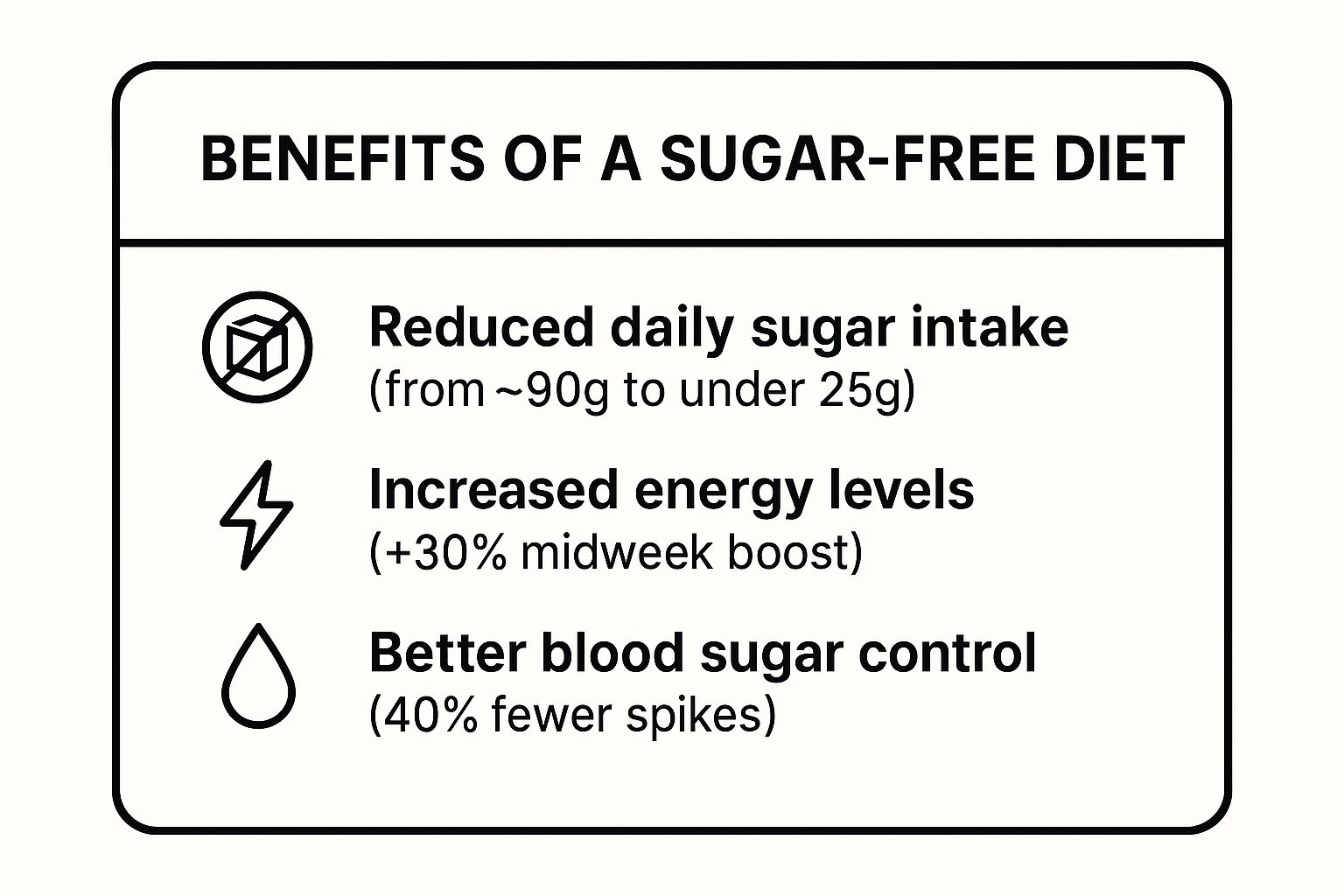
As you can see, reducing daily sugar intake from about 90g to under 25g can significantly boost energy (imagine a 30% increase mid-week!), and improve blood sugar control, with 40% fewer spikes. This translates to more stable energy and fewer cravings throughout the day.
To help you get started, I’ve put together a handy table outlining some common swaps you can make:
Sugar-Free Kitchen Makeover: What Stays vs. What Goes A comprehensive comparison of foods to eliminate versus healthy alternatives to stock in your pantry
| Food Category | Items to Remove | Sugar-Free Alternatives | Hidden Sugar Warning |
|---|---|---|---|
| Breakfast Cereal | Sugary cereals, granola with added sugar | Unsweetened oatmeal, plain yogurt with berries, chia seed pudding | Check labels for "added sugar," "corn syrup," and other sweeteners. |
| Condiments | Ketchup, BBQ sauce, sweet salad dressings | Mustard, sugar-free ketchup, homemade vinaigrette | Many condiments are loaded with hidden sugars. |
| Snacks | Candy, cookies, pastries, sugary granola bars | Fruits, vegetables, nuts, seeds, sugar-free dark chocolate | Even "healthy" snacks can contain surprising amounts of sugar. |
| Drinks | Soda, juice, sweetened tea | Water, unsweetened tea, sparkling water with lemon/lime | Sugary drinks are a major source of added sugar. |
| Dairy | Flavored yogurt, sweetened milk | Plain yogurt, unsweetened almond/soy milk | Opt for unsweetened varieties. |
This table offers a good starting point for revamping your kitchen. Remember, always double-check food labels!
Navigating Shared Spaces and Family Dynamics
Sharing a kitchen can be challenging. Talk to your family or roommates about your goals and explain your reasons for making this change. It’s not about forcing them to go sugar-free, it's about creating a supportive environment for you.
My family was initially skeptical when I told them I was going sugar-free. But once I explained how much better I felt—more energy, fewer mood swings—they understood. They even made some healthier choices themselves!
One helpful tip is designated "sugar zones." If others want sweets, agree on a specific area to keep them—out of your sight and reach. This helps minimize temptation. This article on sugar detox for beginners might also be helpful: Check out our guide on sugar detox.
The Mental Game: Preparing for the Ups and Downs
Finally, prepare yourself mentally. The first few days can be tough. You might experience withdrawal symptoms like headaches, fatigue, and intense cravings. This is totally normal! Your body is adjusting.
Find healthy ways to cope with cravings. Go for a walk, call a friend, or enjoy a hobby. Exercise was key for me. It not only helped manage cravings but also gave me a sense of accomplishment and control.
This journey is about progress, not perfection. Don't beat yourself up over slip-ups. Just get back on track. This is a long-term lifestyle change, not a quick fix. Creating a supportive environment is the first step to sustainable, sugar-free habits. It's all about gradual, realistic changes that fit your life.
Becoming a Sugar Detective at the Grocery Store
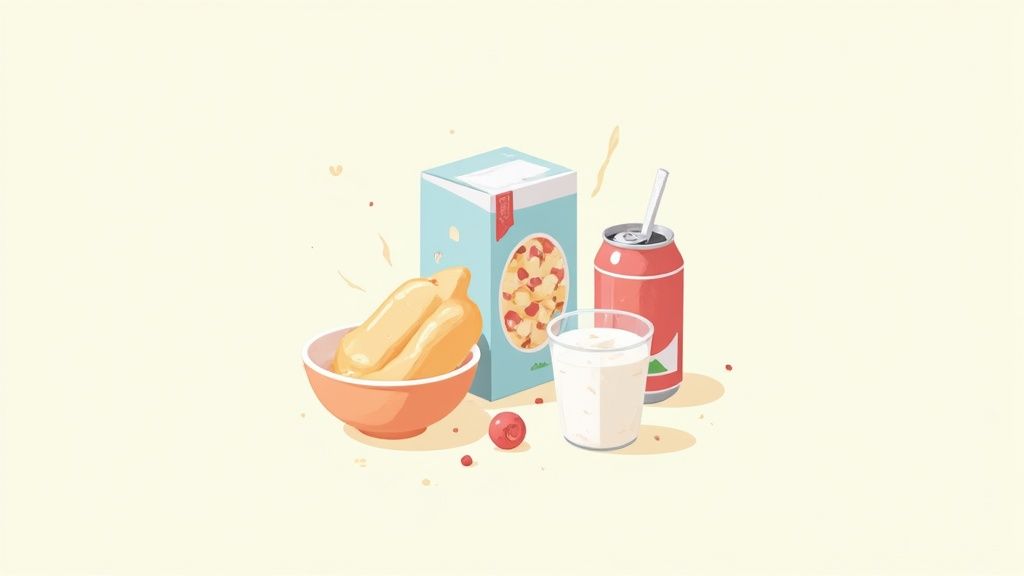
Kicking off a sugar-free diet successfully hinges on one key skill: becoming a sugar detective. Think of your grocery store as your crime scene. Those innocent-looking food labels? They’re covered in clues. You just need to know how to crack the code.
Decoding the Sugar Aliases
The food industry is crafty. They hide sugar under a mountain of different names, making it super easy to miss. Agave nectar, brown rice syrup, dextrose, high-fructose corn syrup—these are just a few of the sugar aliases lurking on shelves. I remember grabbing a "healthy" granola bar once, thinking I was making a good choice. Turns out, it was practically swimming in brown rice syrup! It was a total sugar bomb in disguise. Learning these sneaky names is essential. A good rule of thumb: anything ending in "-ose" (like sucrose, glucose, or fructose) is a sugar.
For example, I used to buy agave nectar thinking it was a healthier alternative to sugar. It sounds all-natural and healthy, right? Wrong. It’s still just concentrated sugar. These hidden sugars can really add up, totally derailing your efforts without you even knowing it.
Marketing Manipulation vs. Reality
Grocery shopping is a battle against clever marketing. Words like "natural," "organic," and even "healthy" can be incredibly misleading. Organic doesn't automatically mean sugar-free. I've seen organic cookies packed with sugar, marketed as a "healthier" choice. Don't be fooled! The ingredient list is where the truth lies. That's where your detective skills come into play.
Also, watch out for "health halo" products. These are the ones that seem healthy but are secretly loaded with sugar. Think of some yogurt brands, for example. They brag about probiotics and fruit, but then sneak in tons of added sugar. Compare labels, and you'll often find a plain yogurt with fresh fruit is the real sugar-free winner.
Spotting the Real Sugar-Free Options
The good news is that there are more and more truly sugar-free products popping up. This growing interest in sugar-free living isn't a fleeting trend; it’s a reflection of a bigger shift towards health and wellness. In fact, the global sugar-free foods market is expected to explode, going from USD 42.5 billion in 2023 to a whopping USD 84.3 billion by 2032, a CAGR of 8.1%. Discover more insights into the sugar-free market.
This means more choices for you, but it also means it's even more critical to sift through the marketing hype and find the genuinely sugar-free gems.
Practical Shopping Strategies
Here are a few tips I've learned from my own sugar-free shopping trips:
- Shop the perimeter: Whole, unprocessed foods like fruits, vegetables, and lean proteins are usually found around the edges of the store.
- Read labels carefully: Don't just glance at the front. The ingredient list on the back is your best friend.
- Make a list and stick to it: Planning your meals and making a list will help you avoid those tempting impulse buys. I used to wander the aisles and grab whatever looked good. A list keeps me focused.
- Don’t shop hungry: Shopping on an empty stomach is a recipe for disaster, especially when you're trying to avoid sugar. Grab a healthy snack before you hit the store.
- Compare brands: Prices and sugar content can be wildly different between brands. Take a moment to compare and get the best value for your health.
These simple strategies can make sugar-free grocery shopping way less stressful and more sustainable. Remember, it’s about making small, lasting changes, not striving for impossible perfection.
Handling Cravings and Social Pressure Like a Pro
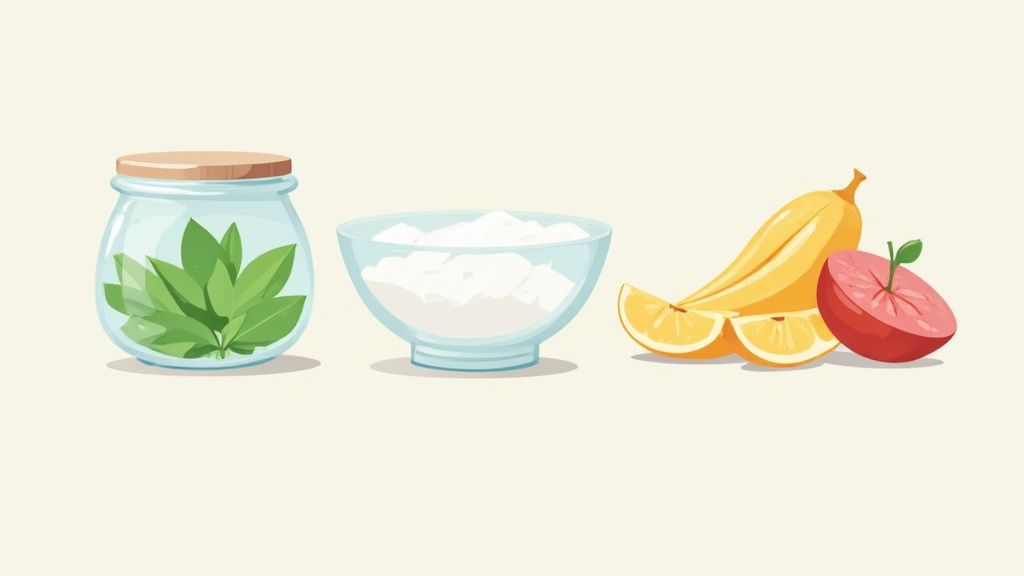
This is where most people trying to ditch sugar hit a wall: the cravings. Intense, almost unbearable cravings. And then, on top of that, you've got friends and family who just don't understand. Believe me, I've been there. Birthdays, holidays, office parties—suddenly, you're the weird one for skipping cake.
But there are absolutely ways to handle these tricky situations and come out on top. Let's talk about some real-world strategies that have helped me and others conquer our sugar demons.
Taming the Sugar Beast: Beyond "Just Drink Water"
Okay, let's be honest. Drinking water is great, but it's not a magic bullet for sugar cravings. You need a more comprehensive approach. This means figuring out when your cravings hit, finding healthy distractions, and having satisfying alternatives on hand.
My cravings always seemed to hit mid-afternoon. Once I realized this, I started prepping. I'd have a small handful of almonds and a piece of fruit ready to go. The healthy fats and natural sugars really helped, and I didn't even think about the candy jar.
Finding distractions that actually work for you is key, too. "Just distract yourself" sounds easy, but what does that even look like in practice? For me, it was a quick walk outside. Fresh air and movement really shifted my focus. For you, it might be calling a friend, listening to music, or losing yourself in a hobby.
Navigating Social Situations: You Don't Have to Be a Hermit
Going sugar-free doesn’t mean becoming a social hermit. It's about finding ways to enjoy social events without compromising your goals. I remember feeling so awkward at first, turning down desserts and sugary drinks. But with a little practice, I found what worked for me.
One surprisingly simple tactic: bring your own sugar-free treat. This gives you something to enjoy while everyone else is indulging, and it also takes the pressure off having to explain yourself.
This is especially helpful during the holidays, office parties, and birthdays. Having a pre-planned response ready can also make these situations much less stressful. A simple, "Thanks, but I'm cutting back on sugar right now," usually does the trick. No need for lengthy explanations or justifications.
The Psychology of Sugar: Understanding Your Triggers
Sugar cravings aren't just about physical hunger. They're often tied to emotions and stress. Early on in my sugar-free journey, I noticed I craved sweets when I felt stressed or overwhelmed. Recognizing this was a game-changer. Instead of grabbing a cookie, I’d find healthier ways to manage stress, like exercise, meditation, or a relaxing bath.
You might find this helpful: Learn more in our article about how to stop sugar cravings. This resource was invaluable for me in understanding the real reasons behind my sugar cravings and developing healthier coping mechanisms.
Emergency Tactics: For Those Unexpected Cravings
Sometimes, cravings will hit you out of nowhere, despite your best efforts. Having a plan for these moments is crucial. Keep some sugar-free gum or mints handy. They can help satisfy that immediate urge for something sweet. Another trick: brush your teeth. The minty freshness can often stop a craving in its tracks.
Finally, remember that slip-ups happen. Don't beat yourself up if you give in to a craving. Just acknowledge it, learn from it, and get back on track. This is a journey, not a race. Be kind to yourself and celebrate your victories, big or small. You've got this!
Building Meal Plans That Keep You Satisfied
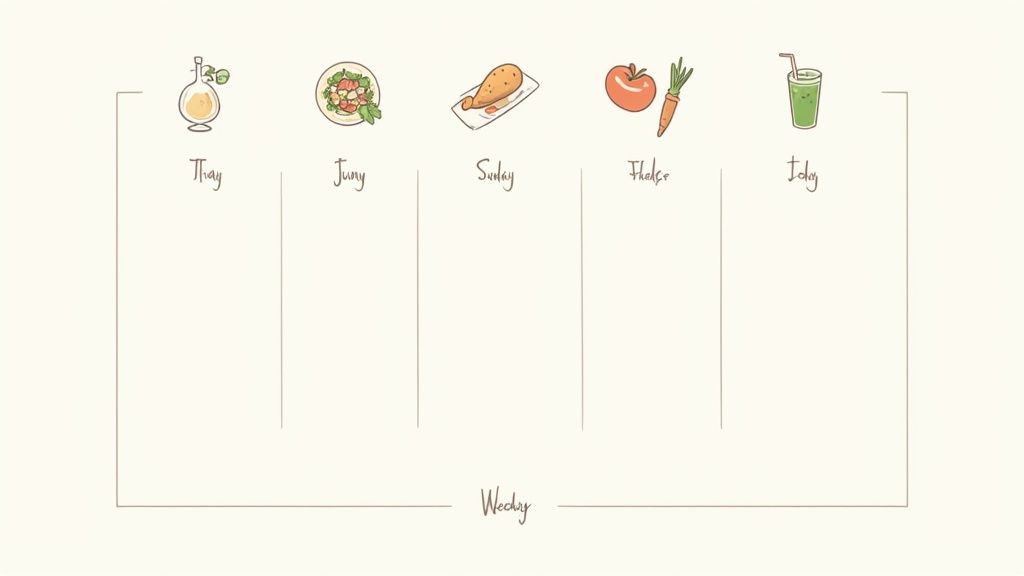
Kicking off a successful sugar-free journey isn't about deprivation; it's about rediscovering how delicious real food can be. It means ditching the processed, sugary stuff and embracing flavorful, satisfying meals that truly nourish your body and tame those sugar cravings. I've found that smart substitutions and a little kitchen creativity can make a world of difference.
The Power of Smart Swaps and Creative Cooking
One of the biggest myths about sugar-free eating is that it's boring and bland. Honestly, that couldn’t be further from the truth! My sugar-free journey has actually taught me to appreciate the natural sweetness in fruits and vegetables and the complex flavors of herbs and spices. For example, I used to load my salads with sugary dressings. Now, I whisk together a simple vinaigrette with olive oil, lemon juice, and herbs—and wow, the flavor explosion! It’s so much more satisfying.
Think about it: ditch the sugary yogurt and try plain yogurt topped with fresh berries and a dash of cinnamon. That afternoon candy bar? Swap it for a handful of almonds and a piece of fruit. These small changes can drastically reduce your sugar intake without sacrificing flavor or satisfaction.
Mastering Meal Prep Without the Fuss
Life gets busy, I know. Spending hours in the kitchen just isn’t realistic. That’s where meal prepping comes in. And it doesn’t have to be complicated. I've found that prepping even a few key ingredients—like chopping veggies or cooking a batch of quinoa—can save a ton of time during the week.
On Sundays, I roast a huge pan of veggies like broccoli, Brussels sprouts, and sweet potatoes. Throughout the week, I toss them into salads, stir-fries, or enjoy them as a simple side. This not only saves time but also makes healthy eating so much easier.
Real-Life Meal Planning for Different Lifestyles
Whether you’re cooking for a family, juggling a hectic work schedule, or enjoying the solo kitchen life, there’s a sugar-free approach that will fit your life. The trick is finding what works for you and creating a sustainable routine.
To give you a jumpstart, here's a sample meal planning template I use:
Weekly Sugar-Free Meal Planning Template A practical meal planning framework showing breakfast, lunch, dinner, and snack options for different dietary preferences
| Meal Time | Standard Option | Vegetarian Option | Quick Option | Prep Time |
|---|---|---|---|---|
| Breakfast | Scrambled eggs with spinach and avocado | Oatmeal with berries and nuts | Protein smoothie | 10-15 minutes |
| Lunch | Salad with grilled chicken or fish | Lentil soup with whole-grain bread | Leftovers from dinner | 5-10 minutes |
| Dinner | Baked salmon with roasted vegetables | Veggie burgers on whole-wheat buns | Stir-fry with tofu and brown rice | 20-30 minutes |
| Snack | Apple slices with almond butter | Handful of trail mix | Hard-boiled egg | 5 minutes |
This is just a starting point. Feel free to tweak it to your own liking and dietary needs. You can also adjust the portion sizes to meet your calorie goals. Remember, variety is the spice of life (and sugar-free living!). Play around with different recipes and flavors to keep things interesting.
Dining Out, Traveling, and Special Occasions
Don't let dining out or travel throw you off track. Most restaurants are happy to accommodate dietary requests. Just ask for dressings and sauces on the side and pick dishes that are naturally lower in sugar.
When traveling, packing healthy snacks like nuts, seeds, and fruit can help you avoid those sugary temptations. And for special occasions? Allow yourself a small portion of your favorite treat and savor every bite. It's about balance, not deprivation.
Kitchen Tools and Efficient Prepping
Having the right tools can make sugar-free cooking so much easier. My kitchen essentials include a good set of knives, a blender, and some airtight containers for storage. These make prepping and storing food a breeze, helping me stay on track.
Batch cooking is another game-changer. I often double or triple recipes and freeze the leftovers for quick meals later on. This saves time and helps me avoid those last-minute unhealthy takeout choices. Creating a sustainable sugar-free lifestyle is all about making smart choices and figuring out what truly works best for you.
Tracking Progress Beyond the Scale
So, you’re on your sugar-free journey. Feeling good, ready for some positive changes? Weight loss might be a big reason why you started, but trust me, it's not the best way to track your success. I've been there, and obsessing over the scale can be a real downer. There's a lot more going on than just pounds lost!
Non-Scale Victories: The Real Transformations
Let's dive into the non-scale victories, those quiet but powerful shifts that show you're truly rocking this sugar-free life. These are the changes that make a real difference in your daily life and make this whole thing feel worthwhile.
For example, one of the first things I personally noticed was how much better I slept. I used to be a restless sleeper, always waking up groggy. After ditching sugar? Sleeping like a baby. Seriously, it was amazing.
Another unexpected perk? My energy levels went through the roof. Remember those afternoon crashes that had you reaching for a sugary pick-me-up? Gone. My energy became so much more stable, and I felt focused and productive all day long.
Beyond sleep and energy, there are even more improvements you might notice. A lot of people report clearer skin, less bloating, and even feeling mentally sharper. These are the types of transformations that really change how you feel, inside and out.
Tracking Meaningful Progress: It’s Not All About the Number
If you're not using the scale, how do you track these changes? A simple journal can work wonders. Just jot down notes about your sleep, energy levels, any cravings you're having, and your overall mood. Looking back on these entries is super motivating, especially when the scale isn't cooperating.
I also love taking progress photos. They're a visual reminder of how far I've come, even if the number on the scale hasn't budged much. Remember, your body composition can be changing even if your weight stays the same.
Real Stories, Realistic Timelines: What to Expect
Everyone's journey is unique. Some people see big changes quickly, others experience a more gradual shift. Chatting with others who have successfully embraced a sugar-free lifestyle can give you a sense of what’s realistic. A friend of mine noticed an immediate energy boost, while another friend saw a slow but steady reduction in bloating over a few weeks.
Things like your age, activity level, and overall health can also affect how quickly you see results. The impact of excess sugar on our health and the environment has spurred a global movement towards sugar-free or reduced-sugar diets. Over the last 60 years, global sugar intake has quadrupled, making up about 8% of our total calorie intake. Cutting sugar by just 20% could save health systems billions – projections for the US alone are around US$10.3 billion. Discover more insights about the impact of sugar consumption here. This highlights how important reducing sugar is, not only for personal health but for the planet's well-being, too.
Handling Setbacks: Ditch the All-or-Nothing Mindset
Setbacks are bound to happen. It’s just part of the process. The important thing is to ditch that all-or-nothing thinking that trips so many people up. One slip-up doesn't mean you’ve failed. Just get back on track with your next meal or snack. I remember one particularly stressful week where I caved and had a sugary treat. I felt awful afterwards, not because of the treat itself, but because I felt like I'd ruined all my hard work. I've learned since then that it's okay to indulge now and then. It’s about finding balance.
Maintaining Motivation: Making Sugar-Free Your New Normal
The initial excitement of a new diet always fades. Totally normal. To stay motivated long-term, figure out what truly works for you and your lifestyle. Some people find joining a supportive community helps. Others like rewarding themselves for reaching milestones (with non-sugary treats, of course!). Play around with different strategies until you find what keeps you going. It’s about making sugar-free eating a natural part of your life, not a temporary thing.
Your Long-Term Success Strategy
So, you've made it this far! Congrats on getting this deep into exploring a sugar-free lifestyle. You're definitely armed with the knowledge and tools to start, but the real magic is keeping it going – not just for a few weeks, but for the long haul. And trust me, it’s less about strict rules and deprivation than you think. It’s really about finding a sustainable approach that works with your life, not against it.
Realistic Expectations and Milestones
Let's be honest, the first month is usually the toughest. You might experience cravings, feel a little sluggish, or even have some social challenges. Totally normal! I remember a friend who was constantly battling afternoon energy crashes. It took a few weeks, but she finally broke free from that sugar-fueled roller coaster.
So, for those first few weeks, focus on small wins. Swapped that sugary soda for sparkling water? Huge! Resisted that tempting dessert at a party? You’re a champion! Trust me, these small victories build momentum.
By month three, you'll likely find things getting easier. A lot of those initial struggles will have eased up, and you'll start to see real, lasting changes in your energy levels, sleep quality, and even your skin. This was definitely my experience. After three months, sugar-free wasn't something I was doing, it was simply how I lived. It had become my new normal.
Beyond those initial months, it's all about fine-tuning and figuring out what works best for you. Listen to your body, experiment with different approaches, and don't be afraid to adjust your strategy. What works for one person might not work for another.
Troubleshooting and Ongoing Support
Let’s face it, life throws curveballs. Stressful periods, big life changes… these can all trigger cravings and make it harder to stick to your goals. Having a plan for these moments is key. Personally, I leaned heavily on my support system during tough times. Talking to friends who understood what I was going through made a world of difference. You can also find amazing support groups or online communities dedicated to sugar-free living.
For a little extra motivation, check out this resource: Learn more in our article about the benefits of quitting sugar. Sometimes, it's good to remind yourself why you started this journey.
Inspiring Others (Without Being the Food Police)
Sharing your success can be incredibly rewarding. But nobody likes being preached to about food! Instead of judging other people's choices, focus on sharing your positive experiences. I've found that leading by example is way more effective than lecturing. When people see how much healthier and happier you are, they'll naturally become curious. Be a source of encouragement and support, not a source of guilt.
This long-term journey requires flexibility, self-compassion, and a willingness to adapt. It's not about perfection; it's about progress. Find what works for you, celebrate your wins – no matter how small – and remember that every step you take is a step toward a healthier, happier you.